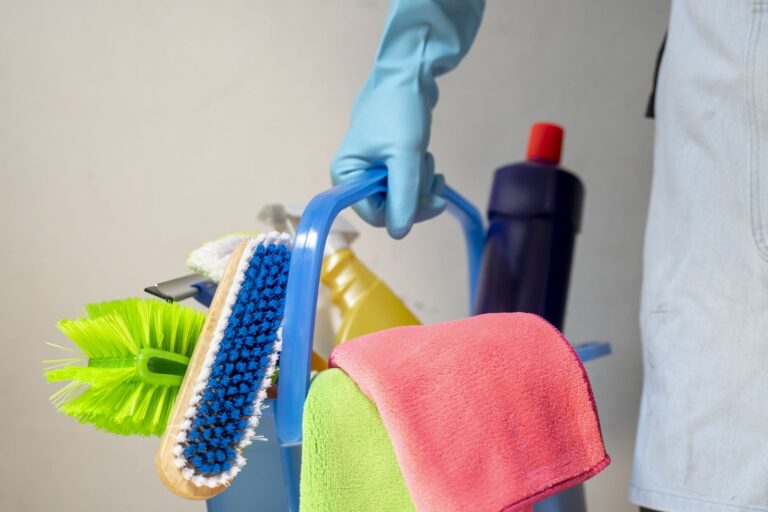The Ultimate Guide to Bathroom Cleaning: Efficient Methods for a Spotless Space

A well-maintained bathroom is essential for maintaining a clean and healthy home. Although it’s a space that requires regular attention, many people find the task daunting – but it doesn’t have to be. The Ultimate Guide to Bathroom Cleaning is here to help simplify the process, ensuring that your bathroom remains spotless and inviting for family members and guests alike.
In this guide, we will provide comprehensive information on various cleaning techniques, products, and tools that can make the bathroom cleaning process more manageable and efficient. From daily maintenance to deep cleaning routines, our aim is to help you conquer the task with ease, transforming your bathroom into a more pleasant sanctuary.
As you venture through the guide, you will learn the best practices for tackling different surfaces and materials, including tiles, glass, and fixtures. With the right approach and consistency, maintaining the cleanliness and hygiene of your bathroom will become second nature, allowing you to enjoy a stress-free and sparkling environment.
Preparation and Safety
Assemble Cleaning Tools and Products
Before starting the bathroom cleaning process, gather all the necessary cleaning tools and products. This will save time and make the cleaning process more efficient. Here are the essential items to have on hand:
- Bucket: A sturdy and spacious bucket to mix cleaning solutions and hold water.
- Mop: Choose a durable mop to clean floors and reach hard-to-reach areas.
- Vacuum: A vacuum to remove dust, hair, and debris from surfaces and floors.
- Gloves: Wear gloves to protect your hands from harsh chemicals and germs.
- Microfiber Cloths: Soft, non-abrasive cloths for wiping and drying surfaces.
- Disinfectant Wipe: Pre-moistened wipes to sanitize surfaces and objects.
- All-Purpose Cleaner: A versatile cleaner for surfaces, tiles, and fixtures.
| Cleaning Product | Purpose |
|---|---|
| Disinfectant Wipe | Sanitize surfaces |
| All-Purpose Cleaner | Clean surfaces |
Remember to read the labels on cleaning products and follow the manufacturer’s instructions for proper usage.
Safety Precautions and Techniques
Safety should always be a priority when cleaning a bathroom. Follow these safety precautions and techniques to ensure a safe and effective cleaning process:
- Ventilation: Always ensure proper ventilation in the bathroom during cleaning. Open windows and doors to minimize the risk of inhaling harmful fumes from cleaning products.
- Protective Gear: Wear gloves and other protective gear as needed. This reduces the risk of skin irritation and potential injury from using cleaning chemicals.
- Correct Usage of Products: Always read labels and follow the instructions on cleaning products. Misusing or mixing cleaning products can lead to harmful fumes or chemical reactions.
- Safe Storage: Keep cleaning products and tools securely stored when not in use. This prevents accidents and keeps dangerous chemicals out of reach of children and pets.
- Avoid Slips and Falls: Use caution when handling water and cleaning products to avoid slippery surfaces. If necessary, put up signs to warn others of potential hazards.
By following these safety precautions and assembling the necessary cleaning tools and products, you’ll be well-prepared to tackle bathroom cleaning with confidence and expertise.
Daily and Weekly Cleaning Routines
Daily Spot Cleaning
In order to maintain a clean and fresh bathroom, make a habit of performing daily spot cleaning. This involves wiping down commonly used surfaces, such as countertops, sinks, faucets, and mirrors, using disinfecting wipes or a damp cloth with a mild cleaning solution.
It is important to frequently replace hand towels and launder them to prevent the spread of germs. Empty trash cans and pick up any clutter that might accumulate throughout the day.
For the toilet area, use paper towels or a toilet brush to clean the bowl and remove any spots or stains. Finally, give the toilet seat and handle a quick wipe with disinfecting wipes for added hygiene.
Comprehensive Weekly Clean
At least once a week, conduct a more comprehensive cleaning of the bathroom to ensure all areas are thoroughly sanitized. Some key steps in a weekly routine are as follows:
- Remove and wash bath mats, shower curtains, and rugs.
- Dust light fixtures, vents, shelves, and window sills.
- Disinfect countertops, sinks, faucets, and mirrors with a solution of equal parts water and vinegar.
- Scrub the shower or bathtub with a mixture of baking soda and water to remove soap scum, mildew, and grime. Rinse the area thoroughly after scrubbing.
- Clean the toilet bowl, seat, lid, and exterior with a disinfectant cleaner.
- Sweep and mop the floor using a solution of water and vinegar or a specialized floor cleaner.
By performing these daily and weekly cleaning routines, you can maintain a pleasant and germ-free bathroom environment for you and your family. Remember to keep your cleaning supplies stocked, such as disinfecting wipes, paper towels, baking soda, and vinegar, to tackle any messes and maintain a sparkling clean bathroom.
Deep Cleaning Techniques
Tackling Tough Mold and Mildew
Mold and mildew thrive in damp and humid environments, making bathrooms the perfect breeding ground. To effectively eliminate these stubborn issues, use a combination of vinegar and baking soda.
- Mix equal parts of vinegar and water in a spray bottle.
- Spray the solution onto the affected areas and let it sit for a few minutes.
- In the meantime, create a paste with baking soda and water.
- Use an old toothbrush or a soft-bristle brush to scrub the paste onto the mold and mildew.
- Rinse with warm water and repeat if necessary.
This deep cleaning technique not only removes mold and mildew but also prevents their reoccurrence.
Removing Hard Water Stains and Soap Scum
Hard water stains and soap scum are unsightly and can diminish the overall appearance of your bathroom. To remove these stains, follow these steps:
- Create a paste using equal parts vinegar and baking soda.
- Apply the paste to the affected areas, such as glass shower doors or fixtures.
- Allow it to sit for 15-20 minutes, allowing the mixture to penetrate the stains.
- Use a soft cloth or sponge to scrub away the residue.
- Rinse thoroughly with water.
The combination of vinegar and baking soda is effective in breaking down hard water stains and soap scum while leaving surfaces sparkling clean.
Cleaning and Maintaining Grout and Tile
Grout can become discolored and dirty over time, affecting the overall appearance of your bathroom. To clean and maintain the grout and tile, use the following method:
- Create a mixture of half a cup of baking soda and water to form a thick paste.
- Apply the paste onto the grout lines using an old toothbrush or a grout brush.
- Allow the paste to sit for 10-15 minutes to break down grime and dirt.
- Scrub the grout lines using the brush, working in a circular motion.
- Rinse the area with water and dry with a clean cloth.
To maintain the cleanliness of grout lines, consider sealing the grout with a grout sealer, and clean regularly using a mild all-purpose cleaner.
By following these deep cleaning techniques, you can restore the beauty of your bathroom surfaces and ensure a pristine, hygienic environment for you and your family.
Cleaning Specific Fixtures and Areas
How to Clean Toilets Like a Pro
First, always wear gloves and make sure to have a good quality toilet brush. Start by applying a toilet cleaner to the inside of the bowl, coating it evenly. While the cleaner is working, use disinfectant wipes or a microfiber cloth to clean the toilet seat, lid, tank, and surrounding areas. Pay special attention to the base of the toilet, as dust and dirt can quickly accumulate there.
Next, use the toilet brush to scrub the bowl, getting under the rim and reaching as far down into the trap as possible. Flush the toilet to rinse the bowl and brush, and then store the brush in a holder. Finally, use a clean towel to dry any wet surfaces.
Keeping Showers and Tubs Spotless
To clean the shower and tub effectively, start by removing any shampoo bottles, soap, and other items. Use a suitable cleaner for your shower walls, such as a tile or glass cleaner, and a separate cleaner for the tub. Apply the cleaner generously, then use a scrub brush or sponge to clean the surfaces, focusing on grout lines and any areas with soap scum.
For faucet handles and showerheads, use a microfiber cloth and a gentle cleaner. Rinse surfaces with water and then dry them with a clean towel.
Making Mirrors and Glass Surfaces Shine
To clean mirrors and glass surfaces, use a high-quality glass cleaner and a microfiber cloth. Spray the glass cleaner onto the cloth and then wipe the surface in a circular motion. Be sure to reach the corners and edges of the mirror or glass to avoid streaks. If you have stubborn spots or streaks, use a clean area of the cloth and buff the surface.
Sink and Counter Hygiene
Maintain a clean and hygienic sink and counter area by regularly removing any toothpaste residue and wiping down surfaces. To clean the sink, start by rinsing it with warm water, then use a mild cleanser and sponge or cloth to clean the inner surface, faucet, and handles. For counter surfaces, use an appropriate cleaner based on the material (e.g., granite, marble, or laminate) and a microfiber cloth.
When cleaning the counter and sink area, be sure to also clean the soap dispenser, toothbrush holder, and any other accessories you may have. Replace towels regularly to maintain cleanliness and prevent the spread of bacteria.
Remember, keeping a bathroom clean takes consistent effort, but a well-maintained space contributes to a healthy and happy home.
Finishing Touches and Maintenance
Refreshing Linens and Towels
A well-maintained bathroom should have fresh linens and towels. Replace towels every three to four days, or more frequently if there’s a lot of humidity in the bathroom. Bath mats should be laundered every week, as they can accumulate dampness, dirt, and bacteria. To maintain good hygiene, it’s essential to wash linens in hot water with a quality detergent and use a high heat setting in the dryer.
Addressing Bathroom Odors and Ventilation
Proper ventilation is crucial for a clean and fresh-smelling bathroom. Ensure that the exhaust fan or a window is open during and after using the bathroom to eliminate odors and prevent moisture build-up. For added freshness, use natural products such as essential oils, baking soda, or vinegar to neutralize smells instead of relying on chemical air fresheners. Good ventilation also helps prevent mold and mildew growth.
Final Checklist for a Cleaner Bathroom
To maintain a spotless bathroom, create a checklist to guide you through a regular deep-cleaning routine. Below is a suggested list of tasks to help you stay on top of your bathroom cleaning needs:
- Daily: Wipe down the sink, faucet, and countertops; rinse and squeegee shower walls; empty the trash can.
- Weekly: Scrub the toilet bowl, clean the showerhead, scrub the bathtub, wash the shower curtain or liner, and mop the floors.
- Monthly: Disinfect trash cans, clean the exhaust fan, wash windows or mirrors, and dust light fixtures.
By incorporating these recommendations into your routine, your bathroom will be clean, fresh, and inviting for all users.







